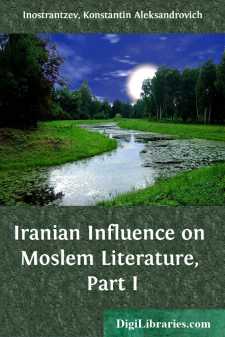Categories
- Antiques & Collectibles 13
- Architecture 36
- Art 48
- Bibles 22
- Biography & Autobiography 813
- Body, Mind & Spirit 142
- Business & Economics 28
- Children's Books 15
- Children's Fiction 12
- Computers 4
- Cooking 94
- Crafts & Hobbies 4
- Drama 346
- Education 46
- Family & Relationships 57
- Fiction 11828
- Games 19
- Gardening 17
- Health & Fitness 34
- History 1377
- House & Home 1
- Humor 147
- Juvenile Fiction 1873
- Juvenile Nonfiction 202
- Language Arts & Disciplines 88
- Law 16
- Literary Collections 686
- Literary Criticism 179
- Mathematics 13
- Medical 41
- Music 40
- Nature 179
- Non-Classifiable 1768
- Performing Arts 7
- Periodicals 1453
- Philosophy 64
- Photography 2
- Poetry 896
- Political Science 203
- Psychology 42
- Reference 154
- Religion 513
- Science 126
- Self-Help 84
- Social Science 81
- Sports & Recreation 34
- Study Aids 3
- Technology & Engineering 59
- Transportation 23
- Travel 463
- True Crime 29
Iranian Influence on Moslem Literature, Part I
Description:
Excerpt
CHAPTER I
Iranian literary tradition in the opening centuries of Islam 1
The character of the Persian history during the Sasanian epoch 6
Importance of this epoch according to the Arab writers of the first centuries of Islam 10
The position of the Parsi community and the centres of the preservation of Persian tradition during the period of the Khalifat in Tabaristan, Khorasan and Fars 15
The castle of Shiz in the district of Arrajan in the province of Fars described by Istakhri, p. 118, 2-4; 150, 14-7; Ibn Hauqal, p. 189, 1-2; cf. the translator of the Khoday Nameh, Behram, son of Mardanshah of the city of Shapur in the province of Fars 19
This castle was the residence of those acquainted with the Iranian tradition (the badhgozar) and here their archives were lodged 20
ARABIC WRITERS AS SOURCES OF SASANIAN CULTURE.
To the Iranian element belongs a very rich rôle in the external as well as the internal history of Islam. Its influence is obvious and constant in the history of the Moslem nations' spread over centuries. Whenever the circumstances have been favourable it has been clearly manifest; when the conditions have been hostile it is not noticeable at the first glance but in reality has been of great consequence. The causes of this are very complicated. And it is necessary on account of its universal value to examine a wide concatenation of facts. But from a general point of view there is no doubt that it has its roots principally in the continuity of the historical and cultural traditions. Particular significance attaches to the circumstance that just in the epoch preceding the Arab conquest Persia had experienced a period of national revival after the horrors that its sovereignty had undergone, at the hands, for instance, of Alexander the Great.[1] Therefore for the study of Iranian tradition in Islam the period of the Sasanian dynasty preceding the Arab conquest has a special significance.
[Footnote 1: This is explained by the hatred given expression to in the
Parsi tradition regarding Alexander. Comp. J. Darmesteter La Legende de
Alexandre chez les Parses. Essais Orientaux, Paris 1883, pp. 227-251.]
The Sasanian dynasty issuing from a small principality in the south of Persia—a principality which, properly speaking bears the title of the "kernel of the Persian nation"—occupies a considerable position in Persian history. Wide imperial aims were united with a plenitude of solid organisation of government so perfect that it passed into a proverb among the Arabs. In this last connection the Sasanian tradition survived for a long time a number of Moslem dynasties. The powerful influence which Iranian tradition exercised was felt by the Abbaside Khahlifs and after them by the Turkish Seljuks. But not only the science of government, a good deal of other matters of cultural and historical importance in the latter times have their explanation in the Sasanian epoch. Placed on the confines of the Greco-Roman world on the one hand, and China and India on the other, Sasanian Persia served during the course of a long time as a central mart of exchange of a mental as well as of a material nature....


